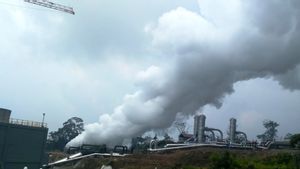JAKARTA - Minister of Industry Agus Gumiwang Kartasasmita said salt is a strategic commodity whose use is very wide. He even said the salt user industry even contributed foreign exchange up to 500 times the value of imported salt.
"The average is five to seven percent per year," said Agus in the technology-based National Salt Industrialization webinar organized by the Economic and Political Discussion Forum (FDEP) with SBE-UISC on Friday, September 24.
However, Indonesia still needs to import this commodity. The reason, salt users are not only households.
Agus said that the largest salt users came from petrochemicals, paper, various foods, pharmaceuticals and cosmetics, to oil mining. The CAP industry alone, he continued, needs 2.4 million tons per year so that the national salt production cannot be sufficient.
He said, in 2021, the total need for salt will reach 4.6 million tons, but data from the Central Statistics Agency (BPS) will not reach 1.5 tons. For this reason, Indonesia must import salt with a value of up to 97 million US dollars in 2020.
However, the salt user industry is also a growing sector in the midst of a pandemic. The reason is that this sector can export with a value of 47.9 billion US dollars.
"This shows how important the salt user industry is," he said.
To follow up, the Ministry of Industry is now trying to encourage an increase in the use of national salt. He even said that his ministry hopes to absorb up to 1.5 million tons of national salt by 2021.
Meanwhile, Deputy Chair of Public Policy & Inter-Agency Relations of the Indonesian Food and Beverage Entrepreneurs Association (GAPMMI) Hermawan Prajudi said that there are still many challenges in the use of national salt such as the difference between production capabilities and national needs, supply sustainability, and the incompatibility of production salt with industrial needs.
Domestic salt content, he said, is still below 90 percent. Meanwhile, industrial salt must at least have a purity level of 97 percent.
Meanwhile, in the pharmaceutical and cosmetic sectors, the purity level is at least 99 percent. However, industrial users are unlikely to stop operations when national salt is not available even though this can cause problems.
"There are many problems if the use of salt is not up to standard," said Hermawan Prajudi at the same event.
One of the problems, salt with a high water content can accelerate product spoilage. In addition, the content of foreign objects in salt can be one of the causes of damaged processing machines until they are rejected by the market and even the presence of foreign objects in food products can trigger consumer complaints.
In fact, the export-oriented food and beverage sector must also meet food safety standards in various countries. The standard does not tolerate foreign substances in food.
Not to mention, Hermawan said that he had found various impurities in domestically produced salt. In fact, metal tracking devices can even detect metals in domestically produced salt.
Because of this, it is difficult for the food and beverage industry to accept salt with a purity level below the standard even though GAPMMI members are eager to use domestically produced salt.
Meanwhile, Professor of the University of Indonesia, Misri Gozan, did not deny the possibility that domestically produced salt did not reach the required purity standards. Therefore, technological intervention is needed in national salt production.
Moreover, national salt production also has many challenges. One of them is natural conditions.
Humidity in Indonesia, said Misri, could reach 90 percent. While in Australia, humidity can be 30 percent.
In addition, not all regions in Indonesia can continue to be in hot conditions for at least 1.5 consecutive months. This period is the shortest time to evaporate seawater.
Moreover, in Indonesia, salt production still relies on evaporation of sea water. While in some other countries, salt is mined from the mountains.
The English, Chinese, Japanese, Arabic, and French versions are automatically generated by the AI. So there may still be inaccuracies in translating, please always see Indonesian as our main language. (system supported by DigitalSiber.id)













